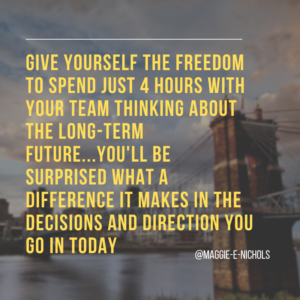 For years I’ve run projects for large companies, small companies, and all in between. And for many of those years, our company used a “gimme the ball” approach to creating ideas. And with each session we focused first and foremost on the objective for the session, to make sure we got the company what they needed. The objective setting conversation went something like this…
For years I’ve run projects for large companies, small companies, and all in between. And for many of those years, our company used a “gimme the ball” approach to creating ideas. And with each session we focused first and foremost on the objective for the session, to make sure we got the company what they needed. The objective setting conversation went something like this…
Them: We’d like to create ideas that we can launch soon – in the next 6-12 months – and also ideas that are further out.
Us: We can help you with either of those, but we know focus helps us increase our odds of success and that’s particularly true with an objective. With 2 targets we minimize our ability to do either one really well. If you had to give a % of effort allocation between the 2 – short term versus long term – what would you say?
Them: I’m not sure, we really need to do both. In all honesty, we like to say we will look further out, but we really end up never getting to that and always staying focused on the short term due to money pressures.
Us: Here’s something to consider, give yourself space with this session to think about the long term. Because when you come in with the mindset of thinking long term, you naturally think bigger and let go of the constraints of today. PLUS, what happens in 99% of cases, when you dream big for the long term and then apply the discipline of breaking down the “death threats” or killer issues…teams often find that what they thought would be impossible today, isn’t. Or, in other cases, they find that they create a vision that impacts the decisions they make on today’s project. And in EVERY case, once you define an audacious idea/goal for the future, it’s the first step in making it more of a reality today.
So how’s about as an innovation leader, you let the team go long on the next one. Rather than solve for something today – let them do the future-focused objective. Do a session on:
– What will we offer to delight customers 15-20 years from now?
– What are future trends and how will we take full advantage of them?
Give yourself the freedom to spend just 4 hours with a team thinking about the long-term future…and then pick 2 ideas to spend just a couple of weeks on to see if you can make them real or learn more. You’ll be surprised what a difference it makes in the decisions and direction you go in today.

